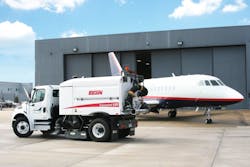There are three main technologies used in modern-day street sweeping: mechanical, pure vacuum and regenerative air. The regenerative air system is most commonly used at airports throughout the world. With highly reliable systems that make clearing runways efficient, regenerative air sweepers offer many benefits.
Most modern-day sweepers operate under a simple principal. The side brooms (comprised of steel or plastic bristles) on the sweeper scour the pavement and sweep the debris under the sweeper. Once the debris is under the sweeper, it can be picked up by another broom or air system.
Regenerative air sweepers, like Elgin’s recently announced RegenX1, start the cleaning process by applying a small amount of water to the pavement. Water is sprayed from small nozzles positioned across the sweeper. Most commonly, these nozzles are attached to the front bumper and near the side brooms (sometimes referred to as “gutter brooms”). The sprayed water aids in the suppression of dust and adds a small amount of mass to the material being collected. Adding mass to the material being collected ensures that even the finest particles are picked up from tarmacs and runways.
The side brooms will then push the weighted material under the truck in front of the "pickup head." The pickup head is approximately as wide as the truck and incorporates a closed loop air flow path to pick up the material. One side of the pickup head is considered a pressurized side, while the other side of the pickup head is considered the vacuum side of the pickup head. An “air knife” is created along the width of the pickup head between the pressurized side and the vacuum side. It is this air knife that agitates material on the pavement and then forces the debris into the sweeper’s hopper. The pickup head on regenerative air sweepers can collect heavier debris, such as leaves, but they really excel when picking up light and medium debris like sand and other fine particulates found at airports.
At busy airports, time is extremely important. Regenerative air sweepers can collect material at higher rates of speed compared to other sweeping technologies. Additionally, regenerative air sweepers utilize high volume airflow at high velocity resulting in exceptional one pass pick up debris, meaning the sweeper does not have to make multiple passes to pick up all of the debris.
Once in the hopper, the air/debris mixture passes through a high efficiency dust separator. Elgin’s dust separator features a centrifugal design that spins air at high speed, isolating dust into a self-emptying collection chamber. The clean air then passes back into the fan which pressurizes the air back down to the pickup head.
Certain options on Elgin regenerative air sweepers are ideal for use at airports. All regenerative air sweepers can be equipped with a wondering hose for precision cleaning like catch basins. A lateral side air blast nozzle can push a high velocity of air to clear away debris from areas that side brooms cannot reach. There is even a regenerative air sweeper, the CrossWind GRS, designed specifically for airports which includes a glycol recovery system.
All Elgin sweepers are innovated using more than 100 years of experience in the sweeping industry. With an established dealer network that provides dependable sweepers to airports across the globe, Elgin is able to provide service and parts for the life of each sweeper.
Tim Letts is a product manager at Elgin Sweeper.
About the Author
Tim Letts
Product Manager
Tim Letts is the product manager at Elgin Sweeper, a leading global manufacturer of street sweepers.
